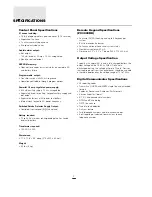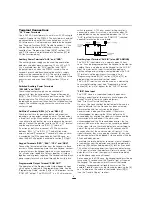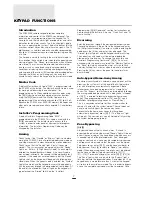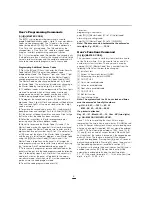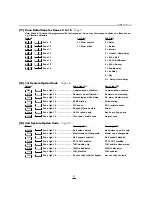
PROGRAMMING
GUIDE
14
Introduction
The PC3000 is programmed by entering instructions from
the panel keypad. The PC3000 memory is EEPROM and
can be reprogrammed thousands of times. The EEPROM
will not lose memory even on total AC and battery failure. All
essential program information required to define the
operation of the control panel and the communicator is
stored in a section of the EEPROM which can only be
accessed using the Installer’s Programming Code. If the
code is forgotten, the default program code can be re-
inserted by using the “Hardware Reset” described on page
22, unless Installer’s Lockout is enabled. See sections [90]
and [91].
To begin programming the PC3000, enter [
Q
], [8], [3000]
while the panel is disarmed. Installer’s Programming can
only be done while the panel is disarmed and not in alarm.
The factory default Installer’s Programming Code is [3000].
This default code can be changed using the Section [24]
command listed below (new Installer’s Code). Once the
basic Installer’s command is entered ([
Q
] [8] [3000]) the
“Program” light will start to flash. The “Program” light will
continue to flash while programming. Note that while
programming, if no key entry is made for more than 2
minutes, the keypad will return to the arm-disarm mode and
the complete installers command ([
Q
] [8] [3000]) must be
entered before programming can resume.
The next step is to enter a 2 digit section entry for any of the
commands described in the following pages. Note that while
the keypad is waiting for the section entry the “Armed” light
is on steady. As soon as the 2 digits are entered for the
section the keypad will beep 3 times, the “Armed” light will
go out and the “Ready” light will go on. The keypad is then
ready to accept data entry for the selected section.
A complete description of each programming section will be
given in the remaining pages of this section. A programming
work sheet summarizing all programming commands is
provided in the next section of the manual. Fill out the work
sheet and use it as a guide when programming.
As the required data for a programming section is entered,
the hexadecimal value of the information in that location is
displayed on zone lights 1-15. Most sections contain several
groups of two digit entries. The keypad beeps twice and the
“Armed” light flashes after each group of two digits is
entered. When the required data is completely entered for
the section being programmed, the keypad will beep 5
times and the “Armed” light will come back on to indicate
that the expected data has been entered and another
section can be selected for programming. After completing
one section, it is not necessary to re-enter the [
Q
] [8]
[Installers’ code] portion of the command. Just enter the
number of another programming section. When
programming a section, it is possible to exit by pressing [#].
Only the data entered before pressing [#] will be changed in
the EEPROM. Practice entering data in several sections
until you become familiar with the programming commands.
Certain programming entries may require “HEX” data. That
is the numbers 0 through 9 and the letters A through F (in
“HEX” numbering the letters A...F represent the numbers
10...15). Where commands require “HEX” data A-F, first
press [
Q
]. The keys 1-6 now assume the hex values A-F and
the “Ready” light begins to flash. Key 1 = A, Key 2 = B, Key
3 = C, Key
4 = D, Key 5 = E and Key 6 = F. Pressing the [
Q
] again
stops the “Ready” light from flashing and the keys assume
the normal values for the numbers from 1 to 9. The most
common mistake in entering “HEX” data is forgetting to
press [
Q
] again after entering the “HEX” digit to return to
normal number entry.
The data for sections 18, 19, 20, 21, 29, 30, 31, 32, 43, 44,
47, 49 and 51 is entered using the keypad zone lights to
indicate which functions are active and the number keys to
turn functions on and off. When the section number is
entered, the zone lights 1...8 will display which functions are
currently on. Pressing the number key corresponding to the
zone light alternately turns the function on and off. All
functions can be turned off by entering [0]. When the
correct selections have been made press [#] to record them
in memory and to go on to program the next section.
Reviewing Programmed Data
Enter the section you wish to review by entering the 2 digit
section number. The zone LED’s will represent the value
(hexadecimal format) of the first digit in that section. Each
press of the ‘F’ key will advance the display to the next digit.
At the end of the section, the keypad buzzer will beep
several times and return you to the program mode where
another section can be selected for review or programming.
Note: Only sections [01] through [17], [22] through
[28], [33], [45], [46], [48], [50] and [52] through [54] can
be reviewed using the above method.
[00] Binary Programming
This section is normally used upon instruction from factory
technical personnel for specialized programming not
covered by the standard programming instructions.
[01] 1st Phone Number
This is the 1st telephone to which the communicator will dial.
See section [33] “Transmission to 1st or 2nd Telephone
Number Options”. After entering the section number [01],
enter the communicator telephone number the way you
would dial it on a telephone. Press [#] after the last digit to
complete the telephone number programming.
Enter [
Q
2
Q
] to dial a ‘
Q
’ (Hex B)
Enter [
Q
3
Q
] for a 4 second pause (Hex C)
Enter [
Q
4
Q
] for additional dial tone search (Hex D)
Enter [
Q
5
Q
] to dial a ‘#’ (Hex E)
The total number of digits including dial tone searches and
pauses must not exceed 16. Remember to press [#] after
Summary of Contents for PC3OOO
Page 1: ...INSTALLATION MANUAL PC3OOO Version 7 51...
Page 40: ...HOOKUP DIAGRAMS 36...
Page 44: ...29000543 R7...


